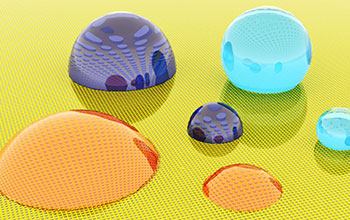Multimedia Gallery
Newly engineered surface can repel liquids in any state of wetness
A newly engineered surface that can repel liquids in any state of wetness.
The lotus leaf, which has a unique microscopic texture and wax-like coating that enables it to easily repel water, has been the inspiration for researchers developing different types of liquid repelling surfaces, but tiny water droplets stick to the lotus leaf structure.
Now, researchers at Penn State, led by Tak Sing Wong, an assistant professor of mechanical engineering and a faculty member at the Penn State Materials Research Institute (MRI), have developed the first nano/micro-textured, highly slippery surfaces able to outperform lotus leaf-inspired liquid repellent coatings, particularly in situations where the water is in the form of vapor or tiny droplets.
Liquid droplets on rough surfaces come in one of two states: Wenzel, in which the droplets are in full contact with the surface, trapping or pinning them; and Cassie, in which the liquid partially floats on a layer of air or gas. Although the Wenzel equation was first published in 1936, it has been extremely challenging to precisely verify the equation experimentally--until now.
"This represents a fundamentally new concept in engineered surfaces," said Wong. "Our surfaces combine the unique surface architectures of lotus leaves and pitcher plants, in such a way that these surfaces possess both high surface area and a slippery interface to enhance droplet collection and mobility. Mobility of liquid droplets on rough surfaces is highly dependent on how the liquid wets the surface. We have demonstrated for the first time, experimentally, that liquid droplets can be highly mobile when in the Wenzel state."
Improving the mobility of liquid droplets on rough surfaces can have applications in areas such as condensation heat transfer for heat exchangers in power plants, water harvesting in arid regions where fog droplets are collected on coated meshes to provide drinking water and irrigation for agriculture, and in the prevention of icing and frosting on aircraft wings.
This research was supported in part by a National Science Foundation (NSF) Faculty Early Career Development (CAREER) (CMMI 13-51462) award and an NSF Graduate Research Fellowship award (DGE 12-55832). The research was performed at the Penn State Nanofabrication Laboratory, part of the National Nanotechnology Infrastructure Network (NNIN), funded by NSF.
To learn more, see the Penn State news story An Engineered Surface Unsticks Sticky Water Droplets. Videos of this research are available on the PennState MRI YouTube page Here. (Date of Image: 2015)
Credit: Xianming Dai, Chujun Zeng and Tak-Sing Wong, Penn State University
Images and other media in the National Science Foundation Multimedia Gallery are available for use in print and electronic material by NSF employees, members of the media, university staff, teachers and the general public. All media in the gallery are intended for personal, educational and nonprofit/non-commercial use only.
Images credited to the National Science Foundation, a federal agency, are in the public domain. The images were created by employees of the United States Government as part of their official duties or prepared by contractors as "works for hire" for NSF. You may freely use NSF-credited images and, at your discretion, credit NSF with a "Courtesy: National Science Foundation" notation.
Additional information about general usage can be found in Conditions.
Also Available:
Download the high-resolution JPG version of the image. (3.2 MB)
Use your mouse to right-click (Mac users may need to Ctrl-click) the link above and choose the option that will save the file or target to your computer.



